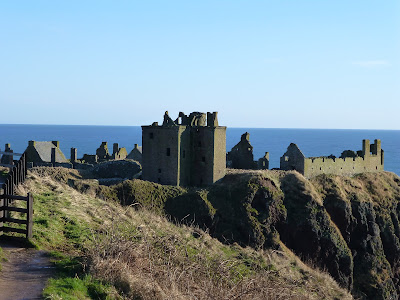For the past 2.5 weeks it's been snowing and a winter wonderland and by winter wonderland I mean huge snow flakes and hail alternating and falling from the sky. The city council doesn't clear the roads unless they are the major roads, so side streets are left to turn to mush during the day and then re-freeze at night and become super slick. The sidewalks on the other hand become so packed down that you usually have ice that is 2-3 inches thick. But this morning we woke up to a beautiful day. The sun was shining and it looked like the snow might just melt away.
We had our chief geoscientist over from the Houston office this week and so we felt we needed to show him a little geology Scottish style. We headed down south along the coast to
Dunnottar Castle. After exploring the castle ruins and grounds we decided it was time to have lunch along the harbor in Stonehaven at
The Marine Hotel. The food there is excellent and dogs are even welcome in the pub! Kady very much enjoyed laying in front of the fire while the rest of us ate our yummy lunches and enjoyed a pint.
After lunch we headed north of Stonehaven to the
Highland Boundary Fault. Here's a little geology lesson for you. The Highland Boundary Fault is a major fault zone that traverses Scotland from the Arran and Helensburgh islands on the west coast to Stonehaven on the east coast. It separates the physiographic and geological terrains known as the Highlands from the Lowlands. To the north and west lie the hard Pre-Cambrian and Cambrian metamorphic rocks of the Dalradian group and to the south and east the softer sedimentary rocks of the Devonian and Carboniferous periods, principally the Old Red Sandstone. The Highland Boundary Fault was active during the Caledonian mountain-building episode. This episode refers to the plate tectonic collision that took place from the Mid Ordovician to the Mid Devonian (520 to 400 million years ago). The Highland Boundary Fault allowed the Midland Valley to descend as a major rift (graben) by as much as 4000 m (12,123 ft). This earlier vertical movement was later replaced by horizontal shear, i.e. strike slip.
(Source)
 |
| Dunnottar Castle |
 |
| Kady smiling to be out in the field |
 |
| Near vertical rocks |
 |
| A beautiful day to walk along the beach |
 |
| The Highland Boundary Fault |
 |
| Pointing out the unconformity |
 |
| Vertical rocks of the Old Red Sandstone |
 |
| Kady and I sitting on the Highland Boundary Fault |



